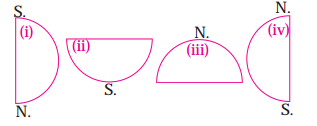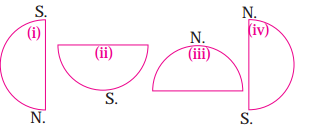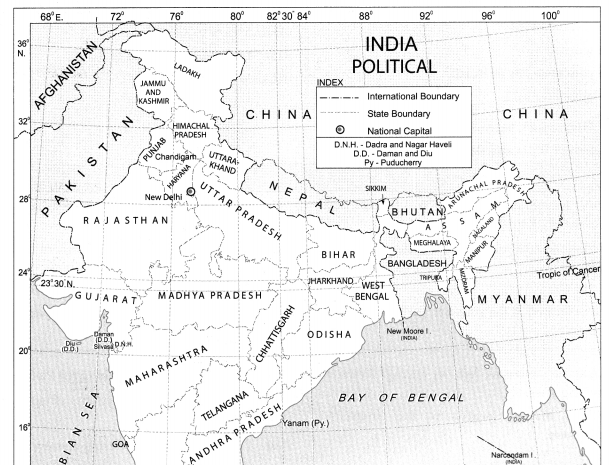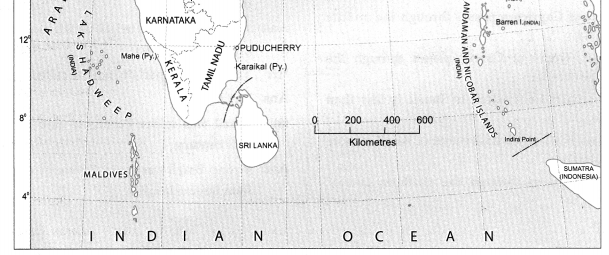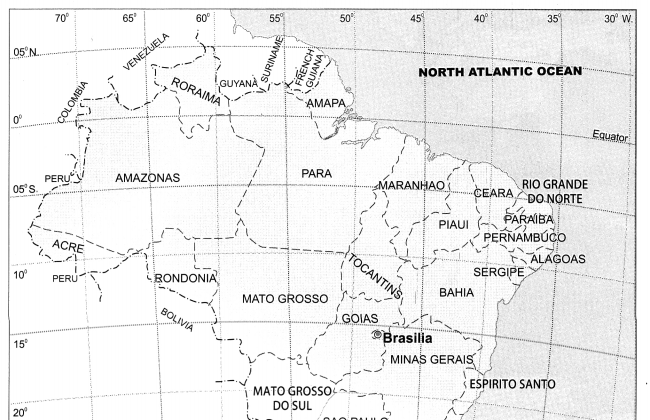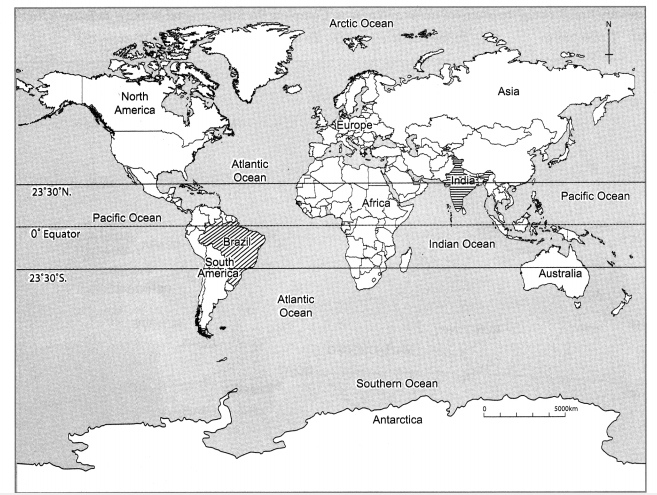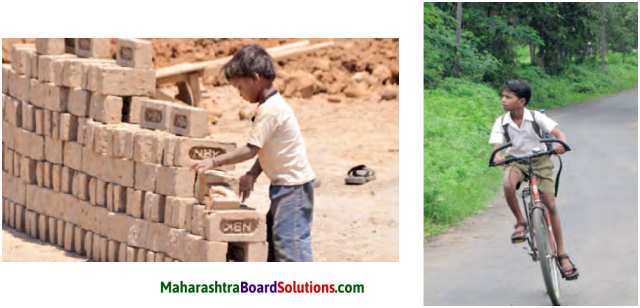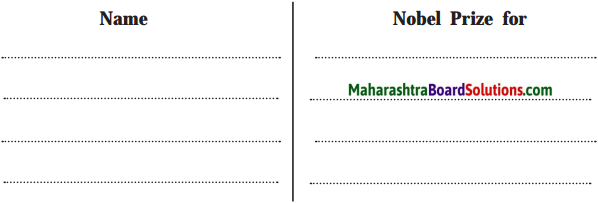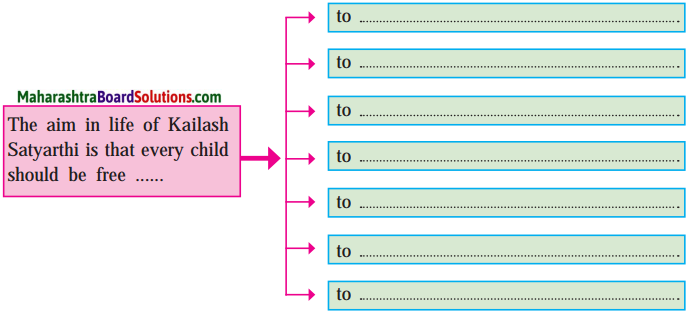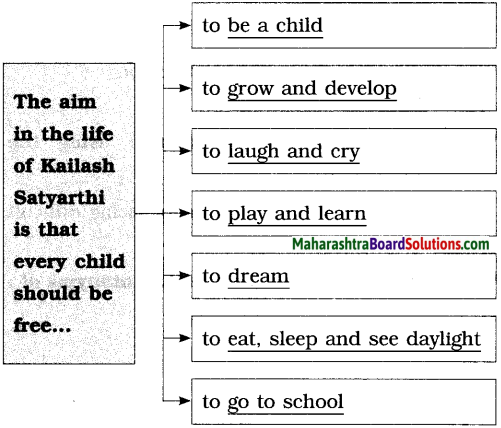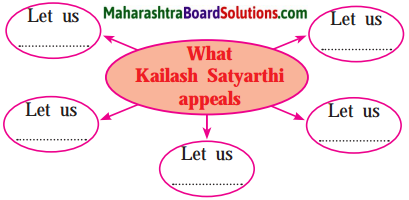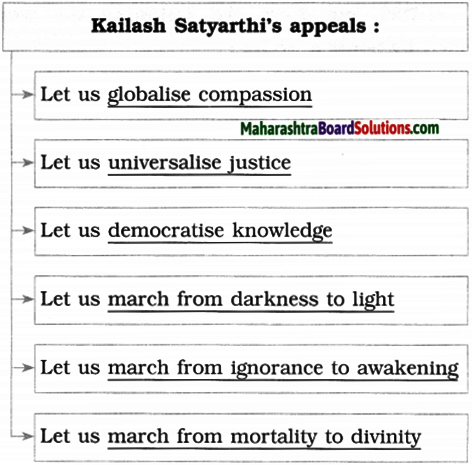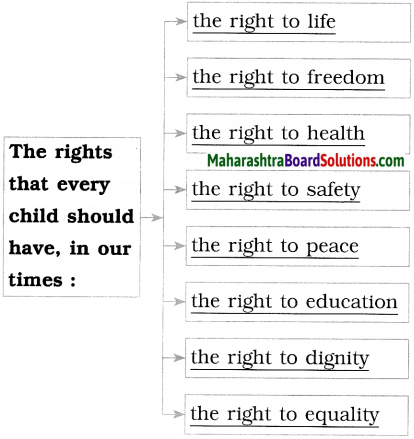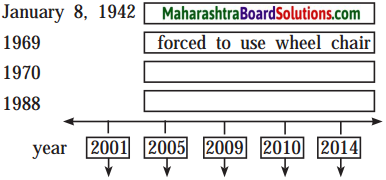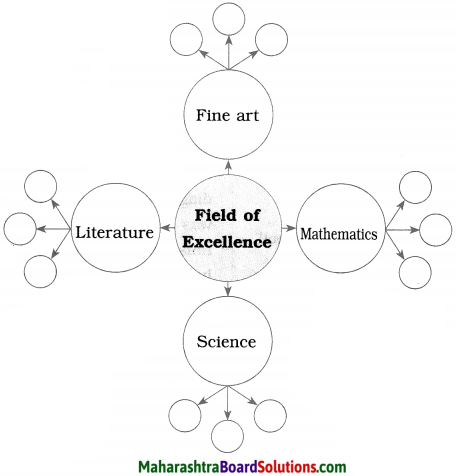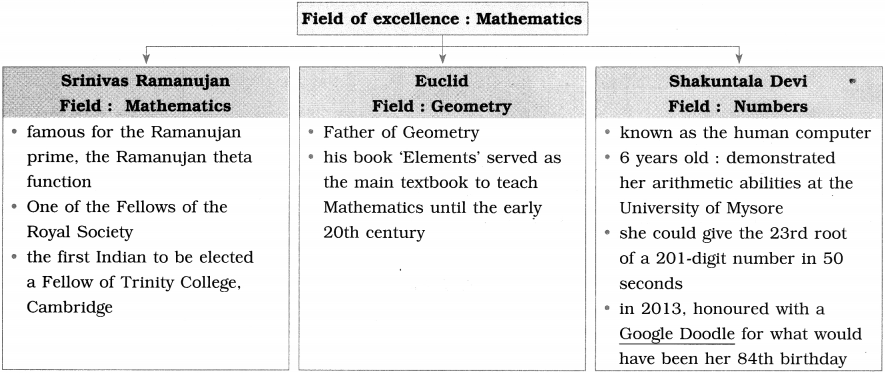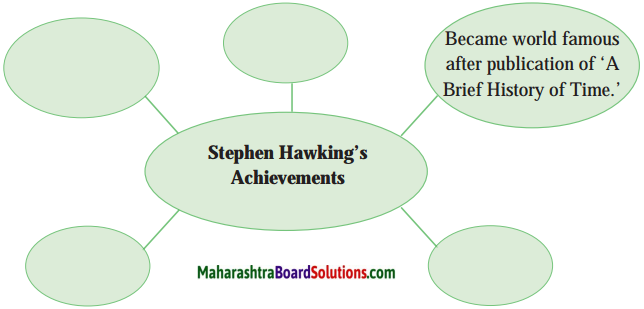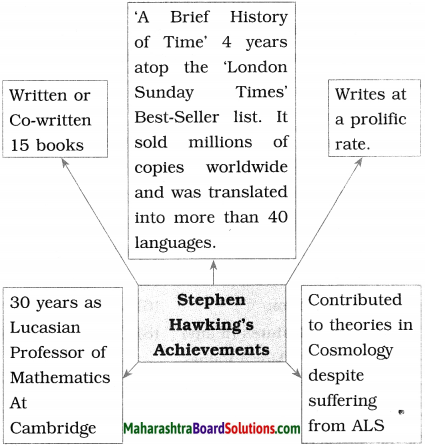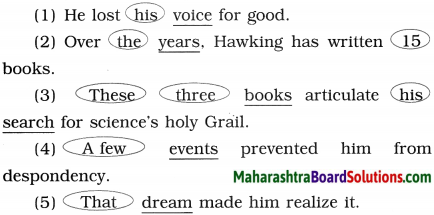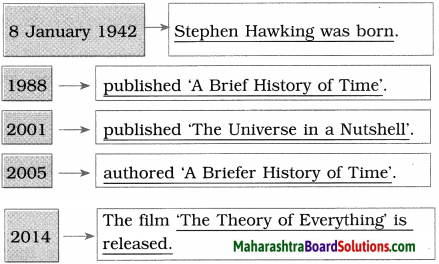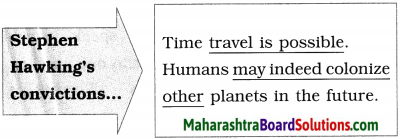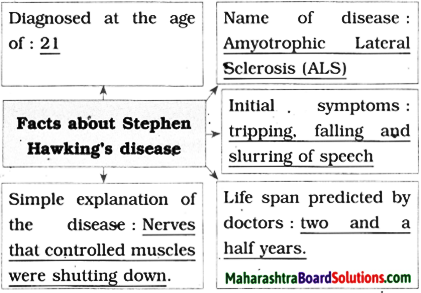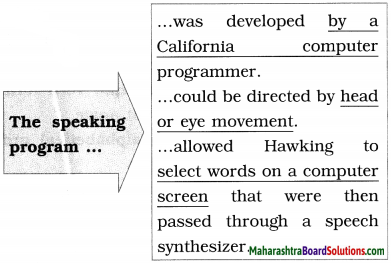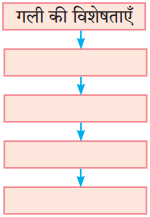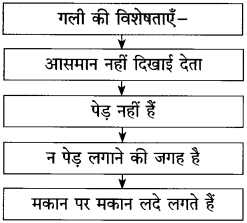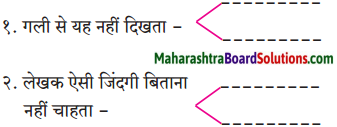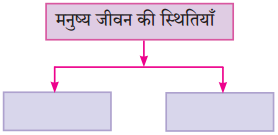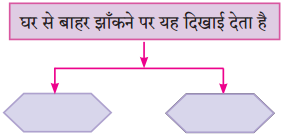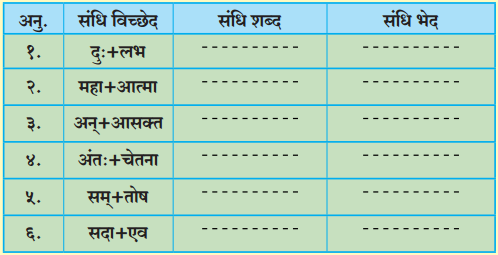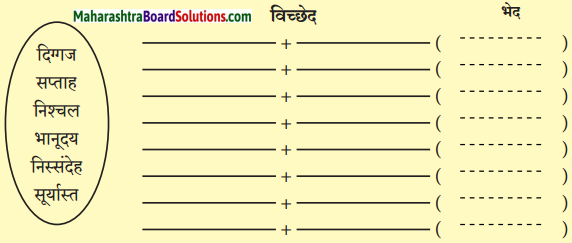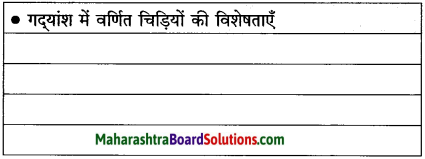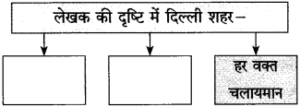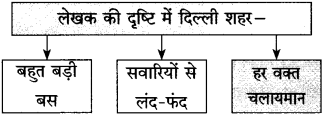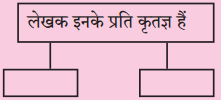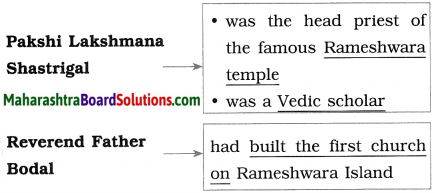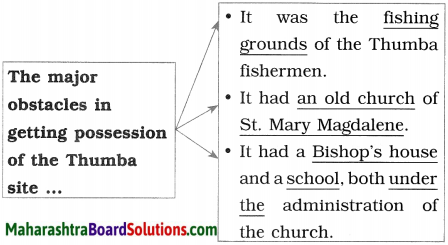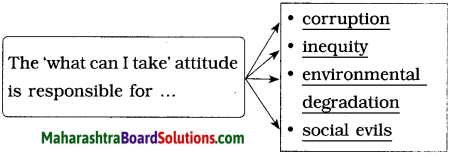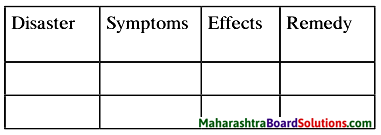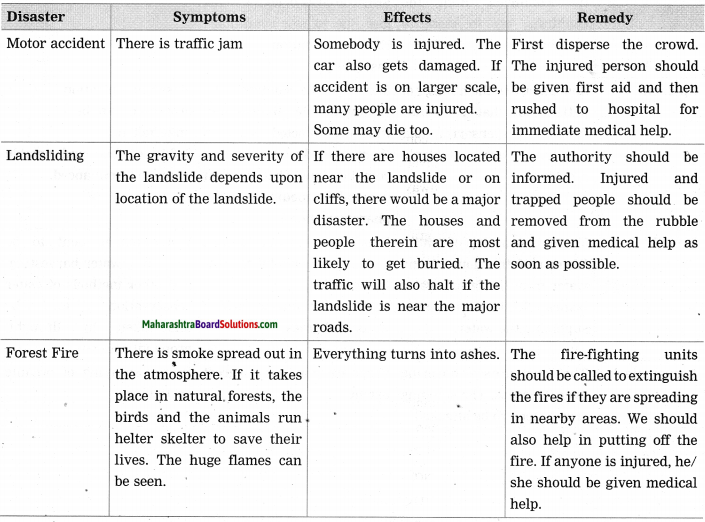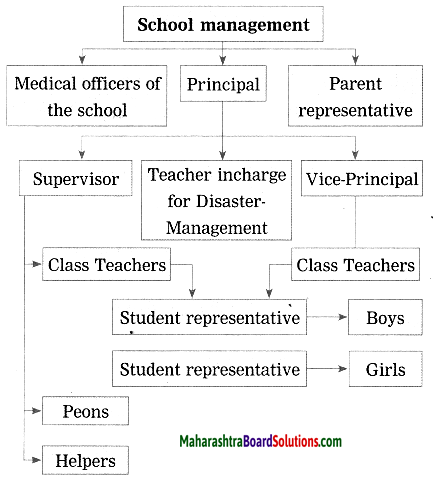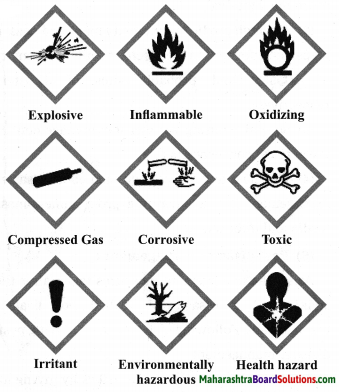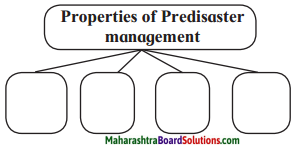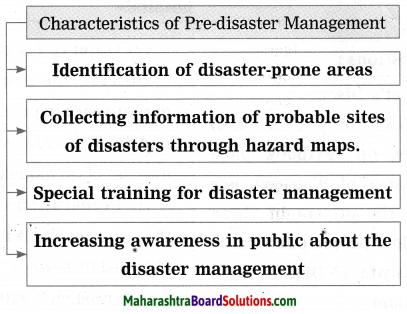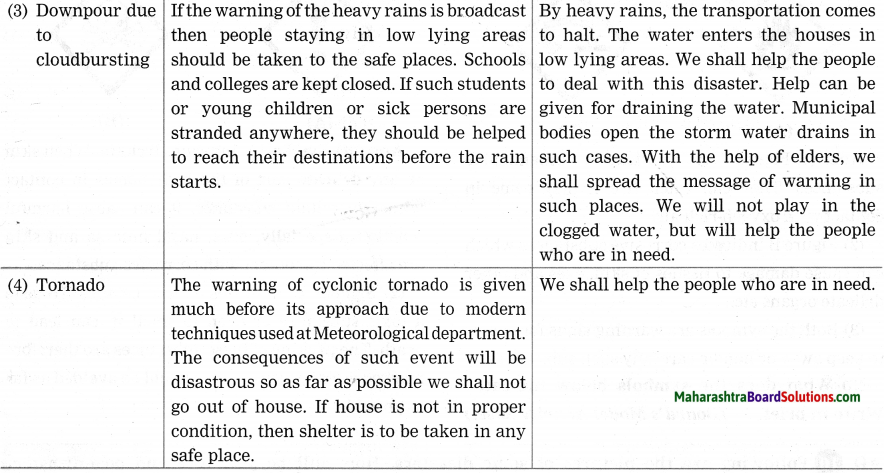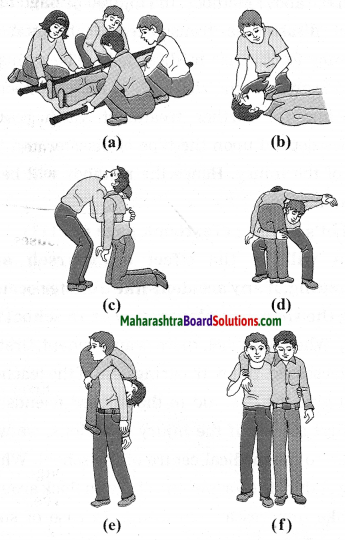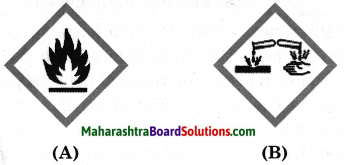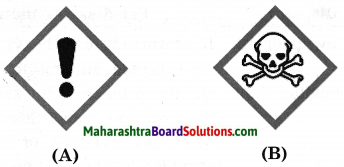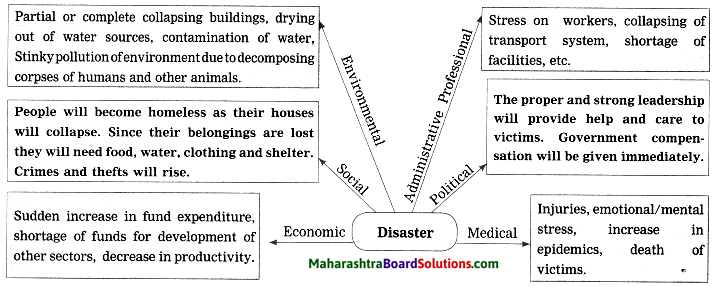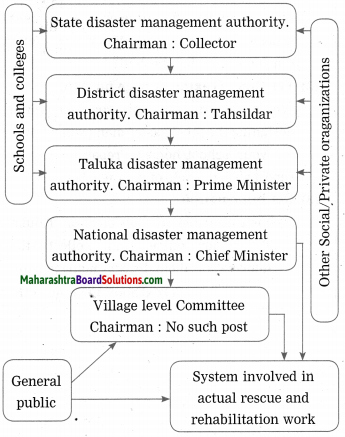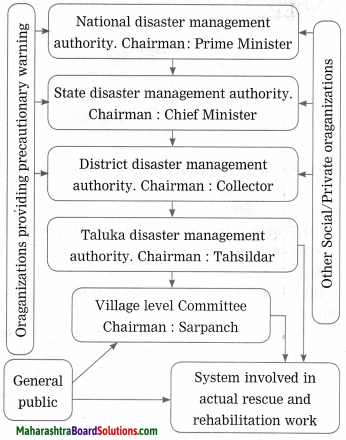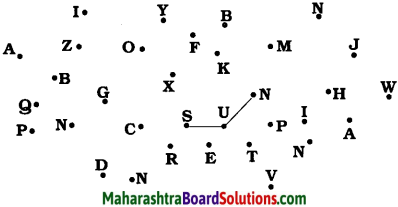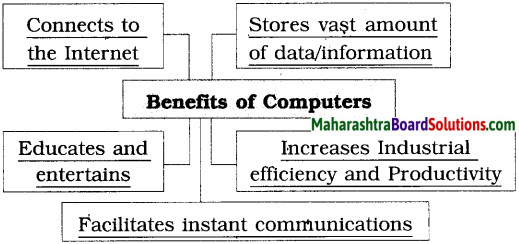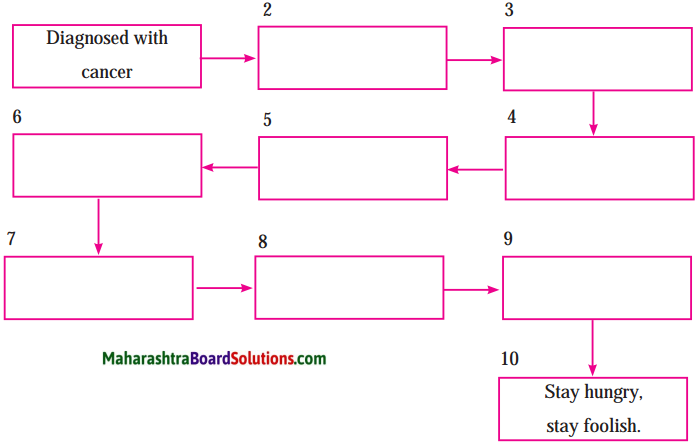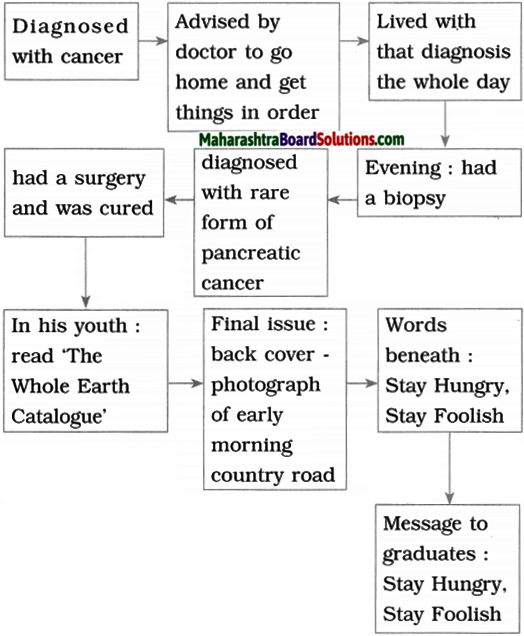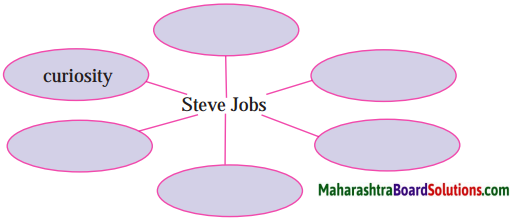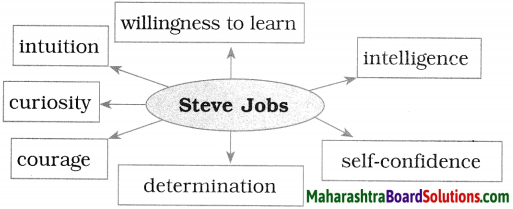Balbharti Maharashtra State Board Class 10 Science Solutions Part 2 Chapter 6 Animal Classification Notes, Textbook Exercise Important Questions and Answers.
Maharashtra State Board Class 10 Science Solutions Part 2 Chapter 6 Animal Classification
Question 1.
a. I am diploblastic and acoelomate. Which phylum do I belong to ?
Answer:
I am from phylum Cnidaria or Coelenterata.
b. My body is radially symmetrical. Water vascular system is present in my body. I am referred as fish though I am not. What is my name?
Answer:
Starfish. I am from Echinodermata phylum.
c. I live in your small intestine. Pseudocoelom is present in my thread like body. In which phylum will you include me?
Answer:
I am Ascaris. I am included in Aschelminthes.
d. Though I am multicellular, there are no tissues in my body. What is the name of my phylum?
Answer:
Sponge, Porifera.
![]()
Question 2.
Write the characters of each of the following animals with the help of classification chart:
a. Bath sponge.
Answer:
Classification:
Kingdom: Animalia
Sub-kingdom: Non-chordata
Phylum: Porifera
Characters:
- Multicellular organisms without cell wall
- Cellular grade organization.
- Asymmetrical body
- Acoelomate
Bath sponge is a marine animal. Blackish in colour and round in shape having porous body. It has spongin fibres and spicules which serve as skeleton. Bath sponges have good water-holding capacity. It is sedentary animal which is fixed to some substratum in the aquatic environment. Reproduction is by budding. It also has a good regeneration capacity.
b. Grasshopper.
Answer:
Classification:
Kingdom: Animalia
Sub-kingdom: Non-chordata
Phylum: Arthropoda
Class: Insecta
Characters:
- Multicellular organisms without cell wall
- Organ-system grade organization
- Bilaterally symmetrical
- Triploblastic and Eucoelomate.
Grasshopper is an insect included under class insecta of phylum arthropoda because it has jointed appendages. There are three pairs of legs and two pairs of wings. It is a terrestrial insect which is well adapted to the surrounding environment by showing camouflage. It has chitinous exoskeleton. The respiration by tracheae.
c. Rohu.
Answer:
Classification:
Kingdom: Animalia
Phylum: Chordata
Class: Pisces
Subclass: Teleostei (Bony fish)
Characters:
- Multicellular organisms without cell wall
- Organ-system grade organization
- Bilaterally symmetrical
- Triploblastic and Eucoelomate.
Rohu is a fresh water bony fish. It is a chordate having a vertebral column, hence included under subphylum vertebrata. The body is well adapted for aquatic mode of life. The shape of the body is streamlined. The exoskeleton is of scales. The gills Eire present which are used for respiration. The endoskeleton is of bones, hence called bony fish. There are paired fins and a impaired caudal fin which is used in steering and changing the direction during swimming.
d. Penguin.
Answer:
Classification:
Kingdom: Animalia
Phylum: Chordata
Class: Aves
Characters:
- Multicellular organisms without cell wall
- Organ-system grade organization
- Bilaterally symmetrical
- Triploblastic and Eucoelomate.
Penguin is a flightless bird inhabitant of cold snow-clad regions. It has exoskeleton of feathers. The body is well adapted to survive in cold regions.
It is a warm-blooded bird. The forelimbs are modified into wings. But due. to excessive body weight, the penguins are not seen flying. It can wade in the water with modified hind limbs.
e. Frog.
Answer:
Classification:
Kingdom: Animalia
Phylum: Chordata
Class: Amphibia
Characters:
- Multicellular organisms without cell wall
- Organ-system grade organization
- Bilaterally symmetrical
- Triploblastic and Eucoelomate.
The frog is a true amphibian that can live in water as well as on land. When on land it respires with the help of lungs while in water it uses its skin for breathing. It does not have exoskeleton. The skin is soft, slimy and moist. It is suitably coloured and hence the frog can camouflage in the surroundings. Body is divisible into head and trunk. Two pairs of limbs are seen. The forelimbs are short and used for support during locomotion. The hind limbs are long and strong, used for jumping when on land and for swimming when in water.
The eyes are large and protruding. Since the neck is absent, such eyes help in looking around. The tympanum is present.
f. Lizard.
Answer:
Classification:
Kingdom: Animalia
Phylum: Chordata
Class: Reptilia
Characters:
- Multicellular organisms without cell wall
- Organ-system grade organization
- Bilaterally symmetrical
- Triploblastic and Eucoelomate.
The lizard is a cold-blooded reptile. The limbs are weak and do not support the body weight, hence lizard is seen creeping. But the feet are provided with pads and suckers due to which lizards are well- adapted to climb on the vertical walls. The exoskeleton has fine scales. The body is divisible into head, neck and trunk. The capacity to regenerate is developed in lizards, hence it can produce the lost tail or limbs. The mode of reproduction is egg laying. It feeds on insects with the help of long and sticky tongue.
g. Elephant.
f. Lizard.
Answer:
Classification:
Kingdom: Animalia
Phylum: Chordata
Class: Mammalia
Characters:
- Multicellular organisms without cell wall
- Organ-system grade organization
- Bilaterally symmetrical
- Triploblastic and Eucoelomate.
Elephant is the terrestrial, herbivorous mammal adapted to survive in hot and humid tropical forests.
It is a mammal and hence shows viviparity and milk secretion. The body is divisible into head, neck, trunk, and tail. The proboscis is a characteristic feature of the elephant which is actually modified nose.
h. Jellyfish.
Answer:
Classification:
Kingdom: Animalia
Sub-kingdom: Non-chordata
Phylum: Cnidaria or Coelenterata
Characters:
- Multicellular organisms without cell wall
- Tissue grade organization
- Radially symmetrical
- Diploplastic and Acoelomate
Jellyfish or Aurelia is a coelenterate. Its body is medusa. It appears as a transparent balloon seen floating in the marine waters. Since it has appearance like a jelly, it is known commonly as jellyfish. There are tentacles provided with cnidoblasts or stinging cells. Tentacles are used for catching the prey. Cnidoblasts are used to secrete a toxin which paralyses the prey.
![]()
Question 3.
Write in brief about progressive changes in animal classification.
Answer:
There were different methods of classification of animals.
- The first classification method was given by the Greek philosopher Aristotle. He took into account the criteria like body size, habits and habitats of the animals. This method was called artificial method of classification.
- The same artificial method was used by other scientists such as Theophrastus, Pliny, John Ray, Linnaeus, etc.
- Further due to advances in science the references were changed and there were some new methods of classification proposed.
- The system of classification called ‘Natural system of classification’ was then proposed. This system of classification was based on criteria such as body organization, types of cells, chromosomes, bio-chemical properties, etc.
- Later, Dobzhansky and Meyer gave the system of classification based on evolution.
- In 1977, Carl Woese has also proposed the three domain system of animal classification.
Question 4.
What is the exact difference between grades of organization and symmetry? Explain with examples.
Answer:
I. Grades of organization:
(1) The grades of organization mean the way an organism has different body formation.
(2) Unicellular organisms like amoeba have a single cell in the body and hence the organization in its body is called protoplasmic grade of organization.
(3) Some organisms have only cells in their body which is called cellular grade of organization, e.g. Poriferans.
(4) Some have tissues e.g. Coelenterates. They are said to have tissue grade organization. Some have organs, they are said to have organization-organ grade, e.g. Platyhelminthes. All other higher animals have organ-system grade organization.
II. Symmetry:
(1) Symmetry on the other hand shows the base of the body formation.
(2) The symmetry can be understood by taking an imaginary cut through the animal body.
(3) Based on the symmetry there can be three types.
(4) In asymmetric animals, there is no symmetry in any plane, e.g. Amoeba.
(5) The bilateral symmetry is the one in which an imaginary axis can pass through only one median plane to divide the body into two equal halves. Most of the animals have bilateral symmetry and hence their organs are arranged in symmetric way on both the sides.
(6) The imaginary cut passing through the central axis but any plane of body aan -give more than one equal half. The organs of such animals are arranged in a radius of an imaginary circle, e.g. Cnidarians and some echinoderms.
Both grades of organization and symmetry are the bases for classifying animals into different phyla.
Question 5.
Answer in brief.
a. Give scientific classification of shark upto class.
Answer:
Kingdom: Animalia
Phylum: Chordata
Subphylum: Vertebrata
Class: Pisces
Subclass: Elasmobranchii (Cartilaginous)
Example: Scientific name: Scoliodon sorrakowah.
Common name: Shark
b. Write four distinguishing characters of phylum – Echinodermata.
Answer:
Distinguishing characters of Echinodermata:
- Marine organisms with skeleton made up of calcareous spines. Calcareous material on the body hence the name is Echiodermata. Some are sedentary while some are free swimming.
- Body is triploblastic, eucoelomate and radially symmetrical when adult. The larvae are bilateral symmetrical.
- Locomotion with the help of tube-feet which are also used for capturing the prey.
- Echinoderms have regeneration capability. Hence they can restore their lost parts.
- Most of them are unisexual.
- Examples; Starfish, sea-urchin, brittle star, sea cucumber, etc.
c. Distinguish between butterfly and bat with the help of four distinguish properties.
Answer:
Butterfly:
- Butterfly is classified as Non-chordate.
- It is included in class Insecta of phylum Arthropoda.
- Butterfly has three pairs of legs and two pairs of chitinous wings.
- Butterfly is a diurnal (active during day) insect.
- Butterfly lays eggs which hatch into larva. Larva develops into pupa and pupa metamorphoses into an adult.
Bat:
- Bat is classified as a Chordate.
- It is included in class Mammalia of subphylum Vertebrata.
- Bat has one pair of legs and a pair of patagium which are used for flying. Patagium has bones.
- Bat is a nocturnal (active at night) mammal.
- Bat is a viviparous animal that gives birth to live young ones. Young ones are fed by milk secreted by mammary glands.
d. To which phylum does Cockroach belong? Justify your answer with scientific reasons.
Answer:
(1) Cockroach belongs to the phylum Arthropoda and class Insecta.
(2) Scientific reasons for placement of Cockroach in the phylum Arthropoda:
- The body is covered by chitinous exoskeleton.
- Jointed appendages present, three pairs of walking legs and two pairs of membranous wings.
- Body is eucoelomate, triploblastic, bilaterally segmented and segmented.
- Respiration by spiracles and tracheal tubes.
![]()
Question 6.
Give scientific reasons.
a. Though tortoise lives on land as well as in water, it cannot be included in class-Amphibia.
Answer:
- When tortoise lives on the land, it respires with the help of lungs.
- When in water, it puts out its nares (nasal openings) out of the water and breathes air.
- It cannot take up oxygen dissolved in water. In both the habitats it respires with the help of lungs. In case of true amphibians, this is not the case.
- They can breathe in water with the help of skin and on land with the help of lungs.
- Tortoise also has exo-skeleton which is lacking in Amphibia. Therefore, tortoise cannot be included in class Amphibia.
b. Our body irritates if it comes in contact with jellyfish.
Answer:
- Jellyfish is a coelenterate that has cnidoblasts bearing tentacles.
- These cnidoblasts inject toxins to paralyse the prey at the time of feeding.
- When jellyfish comes in contact with our body, this toxin is released causing reaction to our skin.
- Therefore, our body gets irritation when we come in contact with jellyfish.
c. All vertebrates are chordates but all chordates are not vertebrates.
Answer:
- All chordates possess notochord in some period of their development.
- All vertebrates also have notochord during embryonic life, which is later replaced by vertebral column.
- Therefore all vertebrates are chordates.
- But some chrodate’s like Urochordata and cephalochordata do not possess vertebral column and hence they are not vertebrates.
d. Balanoglossus is connecting link between non-chordates and chordates.
Answer:
- Balanoglossus shows some characters of non-chordates.
- It also has notochord as in case of chordates.
- Since it shares the characters of non-chordates and chordates, from the view point of evolution, it is called connecting link between them.
e. Body temperature of reptiles is not constant. (Board’s Model Activity Sheet)
Answer:
- Reptiles are cold-blooded animals.
- The thermoregulatory system is not there in their bodies.
- Their body temperatures, fluctuate as per the environmental temperatures.
- Therefore, the body temperature is not maintained at constant level in reptiles.
Question 7.
Answer the following questions by choosing correct option.
a. Which special cells are present in the body of sponges (Porifera)?
1. Collar cells
2. Cnidoblasts
3. Germ cells
4. Ectodermal cells
Answer:
1. Collar cells
Explanation: Porifera animals are attached to the substratum. They do not show locomotion. For gathering and catching the food, they need to produce a current in the water. For this purpose, they have characteristic collar cells in their body. Germ cells and ectodermal cells are seen in all other phyla. Cnidoblasts are characteristic feature of coelenterates.
b. Which of the following animals’ body shows bilateral symmetry?
1. Starfish
2. Jellyfish
3. Earthworm
4. Sponge
Answer:
3. Earthworm
Explanation: When an imaginary plane passing through only one axis can divide the body into two equal halves, then it is called bilateral symmetry. Such symmetry is shown only by earthworm. Sponge body is asymmetrical while starfish and jellyfish are radially symmetrical.
c. Which of the following animals can regenerate it’s broken body part?
1. Cockroach
2. Frog
3. Sparrow
4. Starfish
Answer:
4. Starfish
Explanation: Cockroach, sparrow and frog cannot perform regeneration. Only echinoderms show power of regeneration. So only starfish can regenerate its broken part.
d. Bat is included in which class?
1. Amphibia
2. Reptilia
3. Aves
4. Mammalia
Answer:
4. Mammalia
Explanation: Bat gives birth to young ones and they also possess mammary glands. Amphibia, Reptilia and Aves do not show such features. Therefore, bat is included in Mammalia.
![]()
Question 8.
| Body cavity | Germ Layer | Phylum |
| Absent | _____________ | Porifera |
| Absent | Triploblastic | _____________ |
| Pseudocoelom | _____________ | Aschelminthes |
| Present | _____________ | Arthropoda |
Answer:
| Body cavity | Germ Layer | Phylum |
| Absent | Diploblastic | Porifera |
| Absent | Triploblastic | Platyhelminthes |
| Pseudocoelom | Triploblastic | Aschelminthes |
| Present | Triploblastic | Arthropoda |
Question 9.
| Type | Character | Examples |
| Cyclostomata | …………… | …………… |
| …………… | Gill respiration | …………… |
| Amphibia | …………… | …………… |
| …………… | …………… | Whale, Cat, Man |
| …………… | Poikilotherms | …………… |
Answer:
| Type | Character | Examples |
| Cyclostomata | Jawless mouth with suckers | Petromyzon, Myxine |
| Pisces | Gill respiration | Pomfret, Sea horse, Shark |
| Amphibia | Moist skin without exoskeleton | Frog, Toad, Salamander |
| Mammalia | Mammary glands | Whale, Cat, Man |
| Reptilia | Poikilotherms | Tortoise, Lizard, Snake |
![]()
Question 10.
Sketch, labell and classify.
1. Hydra.
Answer:
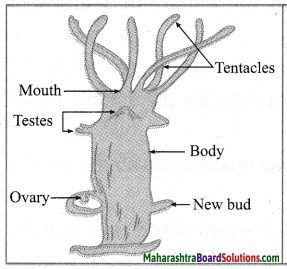
Classification:
Kingdom: Animalia
Division: Non-chordata
Phylum: Coelenterata
Example: Hydra
2. Jellyfish
Answer:
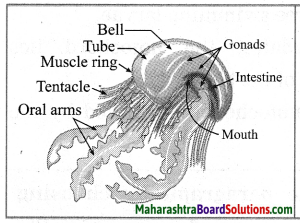
Classification:
Kingdom: Animalia
Division: Non-chordata
Phylum: Coelenterata
Example: Jellyfish
3. Planaria
Answer:
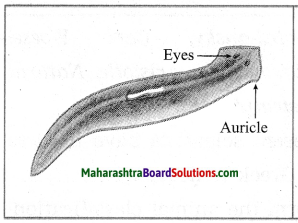
Classification:
Kingdom: Animalia
Division: Non-chordata
Phylum: Platyhelminthes
Example: Planaria
4. Roundworm
Answer:
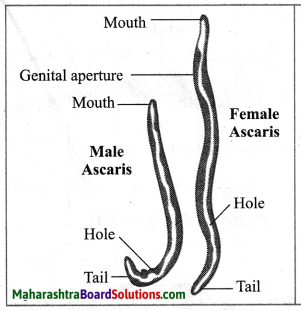
Classification:
Kingdom: Animalia
Division: Non-Chordata
Phylum: Aschelminthes
Example: Ascaris (Roundworm)
5. Butterfly
Answer:

Classification:
Kingdom: Animalia
Division: Non-chordata
Phylum: Arthopoda
Class: Insecta
Example: Butterfly
6. Earthworm
Answer:
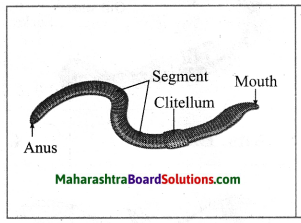
Classification:
Kingdom: Animalia
Division: Non-chordata
Phylum: Annelida
Example: Earthworm
7. Octopus
Answer:
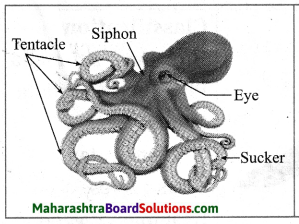
Classification:
Kingdom: Animalia
Division: Non-chordata
Phylum: Mollusca
Example: Octopus
8. star fish
Answer:
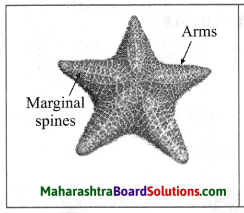
Classification:
Kingdom: Animalia
Division: Non-chordata
Phylum: Echinodermata
Example: Star fish
9. Shark
Answer:
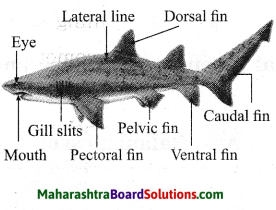
Classification:
Kingdom: Animalia
Phylum: Chordata
Sub Phylum: Vertebrata
Class: Pisces
Example: Scoliodon (Shark)
10. Frog
Answer:

Classification:
Kingdom: Animalia
Phylum: Chordata
Sub Phylum: Vertebrata
Class: Amphibia
Example: Frog
11. Wall Lizard
Answer:
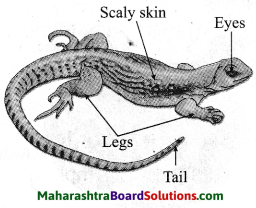
Classification:
Kingdom: Animalia
Phylum: Chordata
Sub Phylum: Vertebrata
Class: Reptilia
Example: Wall Lizard
12. Pigeon.
Answer:
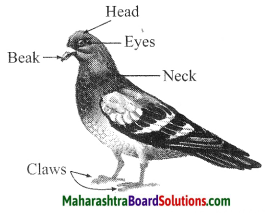
Classification:
Kingdom: Animalia
Phylum: Chordata
Sub-Phylum: Vertebrata
Class: Aves
Example: Pigeon
Question 11.
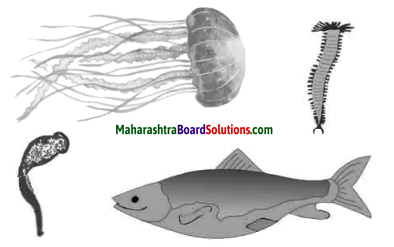
Answer:
(1) Jellyfish
(2) Nereis
(3) Flatworm/Planaria
(4) Bony fish.
Project: (Do it your self)
1. In each week, on a specific day of your convenience, observe the animals present around your school and residence. Perform this activity for six months. Keep date-wise record of your observations. After the observation period of six months, analyse your observations with respect to seasons. With the help of your teacher, classify the reported animals.
![]()
Can you recall? (Text Book Page No. 61)
Question 1.
Which criteria are used for classification of organisms?
Answer:
The living organisms are classified according to their basic characteristics, such as presence or absence of nucleus, unicellular body or multicellular body, presence or absence of cell wall and the mode of nutrition in them.
Question 2.
How are the plants classified?
Answer:
The plants are classified according to the following basis:
- Presence or absence of the organs.
- Presence or absence of separate
Use your brain power: (Text Book Page No. 74)
(A) Animals like gharial and crocodile live in water as well as on land. Are they amphibians or reptiles?
Answer:
Ghariyal and crocodile are reptiles. They can swim in water and crawl on land. But they can respire only with the help of lungs. Their breathing is through nostrils. Even when in water, they have to inhale and exhale by coming up to the surface of water for air. Amphibians can breathe through the skin when in water and by lungs when on land. They also have hard exoskeleton which amphibians do not have. Hence, ghariyal and crocodile are not amphibians, but they are reptiles.
(B) Animals like whale, walrus live in water (ocean). Are they included in Pisces or Mammalia?
Answer:
Whale and walrus are aquatic and marine mammals. They do not belong to class Pisces. They do not have gills to breathe in dissolved oxygen in water. Neither they have scales on the body nor can they lay eggs. Whales and walrus have mammary glands like all other mammals. They give birth to live young one. They breathe only with the help of lungs by putting their nostrils out of the water at surface. Hence they are included in Mammalia.
Choose the correct alternative and write its alphabet against the sub-question number:
Question 1.
System of classification based on evolution was brought into practice by ……….. and …………
(a) Darwin, Mendel
(b) Lamarck, De Vries
(c) Morgan, Mayor
(d) Dobzansky, Meyer
Answer:
(d) Dobzansky, Meyer
Question 2.
Artificial method of animal classification was proposed by ………….
(a) Aristotle
(b) Darwin
(c) Lamarck
(d) Whittaker
Answer:
(a) Aristotle
Question 3.
Animals attached to substratum are called ……….. animals.
(a) sessile
(b) sedentary
(c) lame
(d) motionless
Answer:
(b) sedentary
Question 4.
In coelenterates, ………… are useful for capturing the prey whereas ………. inject the toxin in the body of prey.
(a) tentacles, cnidoblast
(b) hands, legs
(c) flagella, sting
(d) cilia, sting cells
Answer:
(a) tentacles, cnidoblast
Question 5.
Body of annelidan animals is long, cylindrical and …………. segmented.
(a) annular
(b) metamerically
(c) jointed
(d) cuticular
Answer:
(b) metamerically
Question 6.
…………. is second largest phylum in animal kingdom.
(a) Mollusca
(b) Arthropoda
(c) Porifera
(d) Platyhelminthes
Answer:
(a) Mollusca
![]()
Question 7.
Endoskeleton of Cyclostomata animals is …………..
(a) bony
(b) bony and cartilaginous
(c) cartilaginous
(d) none of the above
Answer:
(c) cartilaginous
Question 8.
Body cavity between the body and internal organs is called ………….
(a) gastrocoel
(b) enteron
(c) coelom
(d) cave
Answer:
(c) coelom
Question 9.
Larvae of ……….. metamorphose into adults after settling down at bottom of the sea.
(a) Hemichdrdata
(b) Urochordata
(c) Cephalochordata
(d) Cyclostomata
Answer:
(b) Urochordata
Question 10.
The body organization of unicellular organisms is of …………. grade.
(a) cellular
(b) tissue
(c) protoplasmic
(d) organ
Answer:
(c) protoplasmic
Question 11.
………….. is a cold blooded animal. (March 2019)
(a) Bat
(b) Snake
(c) Rabbit
(d) Elephant
Answer:
(b) Snake
Question 12.
Calcareous spines are present on the body of ………… animal. (July 2019)
(a) fish
(b) snail
(c) sponge
(d) starfish
Answer:
(d) starfish
Question 13.
Due to which similar characteristic honey bee and cockroach are included in the same phylum?
(a) Wings
(b) Three pair of legs
(c) Jointed appendages
(d) Antenna
Answer:
(c) Jointed appendages
Write whether the following statements are true or false with proper explanation:
Question 1.
Greek philosopher Linnaeus was the first to perform the animal classification.
Answer:
False. (Greek philosopher Aristotle was the first to perform the animal classification.)
Question 2.
Heart if present in the non-chordates is on dorsal side of body.
Answer:
True.
Question 3.
Arthropoda animals bear numerous pores on their body.
Answer:
False. (Porifera animals bear numerous pores on their body.)
Question 4.
Porifera animals have special type of collar cells.
Answer:
True.
Question 5.
Aschelminthes have acoelomate and bilaterally symmetrical body.
Answer:
False. (Platyhelminthes have acoelomate and bilaterally symmetrical body. OR Aschelminthes have pseudocoelomate and bilaterally symmetrical body.
![]()
Question 6.
Planet Earth has highest number of animals from phylum Arthropoda.
Answer:
True.
Question 7.
Animals belonging to phylum Annelida perform locomotion with the help of tube-feet.
Answer:
False. (Animals belonging to phylum Echinodermata perform locomotion with the help of tube-feet.)
Question 8.
Herdmania has notochord in only tail region and hence it is called Urochordate.
Answer:
True.
Question 9.
Mammals breathe with the help of lungs.
Answer:
True.
Question 10.
Amphibians are warm blooded.
Answer:
False. (Amphibians are cold-blooded. OR Mammals are warm blooded.)
Match the columns:
Question 1.
| Phylum | Characteristics |
| (1) Mollusca | (a) Collar cells |
| (2) Hemichordata | (b) Mantle |
| (c) Trunk | |
| (d) Cnidoblasts |
Answer:
(1) Mollusca – Mantle
(2) Hemichordata – Trunk.
Question 2.
| Phylum | Characteristics |
| (1) Porifera | (a) Tunic |
| (2) Coelenterata | (b) Collar cells |
| (c) Tentacles bearing cnidoblasts | |
| (d) Mantle |
Answer:
(1) Porifera – Collar cells
(2) Coelenterata – Tentacles bearing cnidoblasts.
Question 3.
| Subphylum/Class | Characteristics |
| (1) Cyclostomata | (a) Collar cells |
| (2) Urochordat | (b) Sucker |
| (c) Tunic | |
| (d) Chitinous exoskeleton |
Answer:
(1) Cyclostomata – Sucker
(2) Urochordata – Tunic.
![]()
Find the odd one out:
Question 1.
Physalia, Hyalonema, Ruplectella, Spongilla
Answer:
Physalia. (Physalia belongs to Coelenterata, all the remaining are poriferans.)
Question 2.
Planaria, Liverfluke, Filarial worm, Tapeworm
Answer:
Filarial worm. (Filarial worm is Aschelminthes remaining are Platyhelminthes.)
Question 3.
Star fish, Sea-urchin, Nereis, Sea-cucumber
Answer:
Nereis. (Nereis belongs to Annelida all the remaining are Echinoderm animals.)
Question 4.
Cockroach, Butterfly, Spider, Honey bee
Answer:
Spider. (Spider is eight-legged Arachnid, remaining are insects.)
Question 5.
Amphioxus, Herdmania, Doliolum,Oikopleura
Answer:
Amphioxus. (Amphioxus is Cepholochordate all the remaining are Urochordates.)
Question 6.
Frog, Tortoise, Toad, Salamander
Answer:
Tortoise. (Tortoise is a reptile, the remaining are amphibians.)
Question 7.
Tube feet, Setae, Parapodia, Sucker
Answer:
Tube feet. (Tube feet are locomotory organs of Echinoderms, the remaining are locomotory organs of Annelids.)
Question 8.
Shark, Sting ray, Electric ray, Pomfret
Answer:
Pomfret. (Pomfret is a bony fish, all the remaining are cartilaginous fish.)
Find the correlation:
Question 1.
Annelida : Earthworm : : Platyhelminthes : …………
Answer:
Annelida : Earthworm : : Platyhelminthes : Planaria/Liverfluke
Question 2.
Horse : Mammal : : Seahorse : ………….
Answer:
Horse : Mammal : : Seahorse : Pisces
Question 3.
Parapodia : Annelida : : Tube feet : ………..
Answer:
Parapodia : Annelida : : Tube feet : Echinodermata
![]()
Question 4.
Frog : Amphibia : : Turtle : …………..
Answer:
Frog : Amphibia : : Turtle : Reptilia
Question 5.
Proboscis : Hemichordata : : Suctorial mouth : …………
Answer:
Proboscis : Hemichordata : : Suctorial mouth : Cyclostomata
Question 6.
Bird from very cold regions : Penguin : : Aquatic Mammal from very cold regions : ………..
Answer:
Bird from very cold regions : Penguin : : Aquatic Mammal from very cold regions : Whale.
Distinguish between:
Question 1.
Non-chordates and Chordates.
Answer:
Non-chordates
- Non-chordates are less evolved animals and are on the lower levels of evolution.
- Non-chordates do not have notochord.
- In non-chordates, there are no pharyngeal gill slits.
- Nerve cord, if present is double and solid.
- Nerve cord is located on the ventral side of the body.
- Heart if present is on the dorsal side of the body.
Chordates:
- Chordates are more evolved animals and are on the higher levels of evolution.
- Chordates have notochord at least in some stage of development.
- In chordates, there are pharyngeal gill slits.
- Nerve cord is single and hollow.
- Nerve cord is located on the dorsal side of the body.
- Heart if present is on the ventral side of the body.
Question 2.
Phylum Platyhelminthes and Phylum Aschelminthes. OR Write any two points of differences between flat worms and round worms.
Answer:
Phylum Platyhelminthes (Flat worms):
- Platyhelminth worms have slender and flat leaf or strip like body hence called flat worms.
- Platyhelminthes are triploblastic and acoelomate.
- Most of them are hermaphrodite or bisexual having both male and female reproductive systems in the same body.
- Examples: Planaria, Liver fluke, Tapeworm, etc.
Phylum Aschelminthes (Round worms):
- Aschelminthes have long thread-like or Cylindrical body, hence called round worms.
- Aschelminthes are triploblastic and pseudocoelomate.
- They are unisexual with male and female sexes separate. There is sexual dimorphism.
- Examples: Ascaris (Intestinal worm), Filarial worm, Loa loa (Eye worm), etc.
![]()
Question 3.
Urochordata and Cephalochordata.
Answer:
Urochordata:
- Urochordates have notochord in the tail region of the adult body.
- These animals look like small sacs.
- Usually urochordates are hermaphrodites.
- Body of urochordate is covered over by skin-like test or tunic.
- Examples: Herdmania, Doliolum, Oikopleura, etc.
Cephalochordata:
- Cephalochrodates have notochord in the entire length of the body.
- These animals look like small fish.
- Cephalochordates are unisexual.
- Body of cephalochordate is not covered in a test.
- Example: Amphioxus.
Question 4.
Cyclostomata and Pisces.
Answer:
Cyclostomata:
- Cyclostomata are the poorly evolved first class of vertebrate animals.
- Cyclostomata have circular jawless mouth with suckers.
- Paired appendages are absent in cyclostomates.
- Cyclostomes have soft skin which is without any scales.
- Endoskeleton is cartilaginous.
- Examples: Petromyzon, Myxine, etc.
Pisces:
- Pisces are the better evolved class of vertebrates which is well adapted for aquatic living.
- Pisces have mouth with upper and lower jaws. Teeth are present in the mouth.
- Paired and unpaired fins present in all kinds of fishes.
- Fishes have different types of scales on the body.
- Endoskeleton may be cartilaginous, or it may be bony.
- Examples: Shark (Scoliodoh), rays which are cartilaginous fishes and pomfret, makerel, sardines, rohu which are bony fishes.
Question 5.
Amphibia and Reptilia.
Answer:
Amphibia:
- Amphibians can inhabit both land and water. They can survive on both environments by breathing there.
- The exoskeleton is absent in amphibians. The skin is soft, slimy and moist.
- Body is divided into head and trunk. Neck is absent.
- The digits do not have claws.
- The respiration is by skin when in water and by lungs when on land. The larvae breathe by gills.
- There is external fertilization at the time of sexual reproduction.
- The developmental stages are eggs and tadpole. Metamorphosis is seen in amphibians.
- Examples : Frog, Toad, Salamander, etc.
Reptilia:
- Reptilians are terrestrial animals. Though turtle and sea snakes can stay in water, they cannot breathe in water.
- The exoskeleton in the form of scales. Some animals have plates or scutes (e.g. tortoise and crocodile).
- Body is divided into head, neck and trunk.
- The digits have claws.
- The respiration is only by lungs.
- There is internal fertilization at the time of sexual reproduction.
- The developmental stages are eggs and juvenile. Metamorphosis is not seen in reptiles.
- Examples : Tortoise, Lizard, Snake, etc.
![]()
Question 6.
Aves and Mammalia.
Answer:
Aves:
- Aves are totally adapted for the aerial mode of life.
- Body is spindle shaped. Body is divisible into head, neck and trunk. There are two pairs of limbs. The forelimbs are modified to form wings for flight.
- Digits have scales and claws.
- The exoskeleton is in the form of feathers.
- Jaws are modified into a beak.
- Birds are oviparous. The eggs hatch into nestlings.
- The incubation of eggs and feeding of nestlings is done by both parents.
- Examples: Crow, Sparrow, Peacock, Parrot, Pigeon, Duck, Penguin, etc.
Mammalia:
- Mammals are adapted for terrestrial life.
- Body is not spindle shaped. It is divisible into head, neck, trunk and tail. There are two pairs of limbs. They are adapted for walking or running on the ground.
- Digits have nails or hoofs. Few have claws.
- The exoskeleton is in the form of fur, hair, wool, etc.
- Jaws have teeth and they surround the mouth.
- Mammals are viviparous. They give birth to live young ones. (Exception: Platypus)
- Parental care is shown only by mother, who feeds, the babies with milk from mammary glands.
- Examples: Cat, Dog, Tiger, Lion, Elephant, Human, Kangaroo, Dolphin, Bat, etc.
Classification-based questions:
Question 1.
Identify me:
(1) I am metamerically segmented, blood sucking, ectoparasite. I have suckers. Who am I and to what phylum do I belong to? (OR) Who am I? (July 2019)
I have suckers. I am blood sucking.
Answer:
Leech, Phylum Annelida.
(2) I have chitinous exoskeleton, I have four pairs of walking appendages. I can sting you. Who am I? What phylum do I belong to?
Answer:
Scorpion. Phylum Arthropoda.
Question 2.
Characters of a phylum are given below. Read them carefully and answer the questions:
(a) Spines of calcium carbonate are present on the body, (b) These animals are exclusively marine, (c) They perform the locomotion with the help of tube feet, (d) Their skeleton is made up of calcareous plates or spicules.
(i) Animals of which phylum show the above character?
Answer:
Animals belonging to phylum Echinodermata show the above characters.
(ii) Give an example from that phylum.
Answer:
Starfish, brittlestar, sea urchin.
(iii) These animals can be classified with the help of which criteria of new system of animals classification.
Answer:
Animals are classified on the basis of criteria such as body organization, body symmetry, body cavity, etc.
Question 3.
Identify my class/phylum and give one example of it: (March 2019)
(a) I have mammary glands and exoskeleton in the form of hair.
(b) We form the highest number of animals on the planet. We have bilateral symmetry and our exoskeleton is in the form of chitin.
(c) I live in your small intestine, my body is long and thread like and pseudocoelomate.
Answer:
(a) Class: Mammalia, Example: Cat, Dog, Man.
(b) Phylum: Arthropoda, Example: Prawn, Crab.
(c) Phylum: Aschelminthes, Example: Ascaris or round worm, Filarial worm.
![]()
Question 4.
Tell me who am I? What is my class/ phylum?
1. My body is divided into proboscis, collar and trunk. I am marine animal.
Answer:
Balanoglossus; Phylum: Hemichordata.
2. I stay inside two shells. My body is divided into head, foot and visceral mass.
Answer:
Bivalve or Oyster; Phylum: Mollusca.
3. I am male as well as female. I am endoparasite having a coelomate and bilaterally symmetrical and flattened body.
Answer:
Liver fluke or tape worm; Phylum: Platyhelminthes.
4. I am sedentary marine animal drinking water all the time through numerous pores on the body.
Answer:
Sponge; Phylum: Porifera.
5. I am venomous, eight legged creature having chitinous exoskeleton.
Answer:
Scorpion; Phylum: Arthropoda.
6. My body is covered by tunic. As a larva I swim but as an adult I settle down.
Answer:
Doliolum or Salpa; Phylum: Chordata subphylum : Urochordata.
Question 5.
Identify the class of given animals and write one characteristic of each animal:
(1) Kangaroq (2) Penguin (3) Crocodile (4) Frog (5) Sea-horse. (July 2019)
Answer:
(1) Kangaroo: Class Mammalia. It is a marsupial animal with pouch for development of offspring. Long hind limbs for jumping.
(2) Penguin: Class Aves. It is flightless bird. Body covered with thick feathery coat. Oviparous mode.
(3) Crocodile: Class Reptilia. It is a large animal seen near water bodies. Can swim in water but cannot respire in water. Body covered with exoskeleton of scaly plates. Limbs very weak in comparison with huge bodies.
(4) Frog: Class Amphibia. Shows aquatic as well as terrestrial mode. Can breathe with lungs and skin. No exoskeleton and skin is slimy.
(5) Sea-horse: Class Pisces. Bony fish. Highly modified body structure showing brood pouch for development of offspring gills for respiration, fins for swimming.
Answer the following questions:
Question 1.
State any four benefits of animal classification. (March 2019)
Answer:
- Studying the different animals becomes easy when they are placed under different groups.
- When few representative animals of the particular group are studied then the idea about other animals belonging to that group also becomes clear.
- The animal evolution becomes easier to follow after studying classification.
- The identification of animals can be done accurately.
- Relationship of the different animals with each other and with other groups can be understood clearly.
- Habitat of each animal and its role in nature is understood by classification.
- Various adaptations are understood by learning classification.
Question 2.
Into which phyla is Non-chordata divided? In which three subphyla are Chordates divided?
Answer:
I. The phyla of Non-chordata:
- Protozoa
- Porifera
- Coelenterata or Cnidaria
- Platyhelminthes
- Aschelminthes
- Annelida
- Arthropoda
- Mollusca
- Echinodermata
- Hemichordata
II. The subphyla of Chordata:
- Urochordata
- Cephalochordata
- Vertebrata
![]()
Question 3.
Write the characteristics of chordates.
Answer:
Characteristics of Chordates:
- All chordates possess notochord and pharyngeal gill slits in at least during some developmental stage.
- Presence of single, tubular and dorsally located spinal cord and ventrally located heart.
Question 4.
Write the characteristics of vertebrates.
Answer:
Characteristics of vertebrates:
- In vertebrates, notochord is replaced by vertebral column.
- Development of head is complete.
- Well-developed cranium which protects the brain.
- Presence of endoskeleton which is either cartilaginous or bony.
- Presence of jaws as in Gnathostomata or absence of jaws as in Agantha.
Write short notes on:
Question 1.
(1) Benefits of classification.
Answer:
- Studying the different animals becomes easy when they are placed under different groups.
- When few representative animals of the particular group are studied then the idea about other animals belonging to that group also becomes clear.
- The animal evolution becomes easier to follow after studying classification.
- The identification of animals can be done accurately.
- Relationship of the different animals with each other and with other groups can be understood clearly.
- Habitat of each animal and its role in nature is understood by classification.
- Various adaptations are understood by learning classification.
Question 2.
Germinal layers.
Answer:
- During the initial embryonic period of any multicellular animal there is formation of germinal layers or germ layer.
- These germ layers give rise to new tissues in the developing animal.
- The primitive animals were diploblastic i.e. they have only two germ layers called ectoderm and endoderm.
- The higher animals are triploblastic, having three germ layers; ectoderm, mesoderm and endoderm.
- Cnidarians are diploblastic while all other animals are triploblastic.
Question 3.
Coelom.
Answer:
- Coelom means body cavity. It is situated between the body wall and the internal organs of the body.
- The coelom is formed during early embryonic life in case of multicellular animals. It is formed from either mesoderm or gut.
- Coelom when present in the body, those animals are called eucoelomate. Phylum Annelida onwards are eucoelomate animals. They are animals with true body cavity.
- Those animals in which coelom are absent are called acoelomate animals. Porifera, Cnidaria and Platyhelminthes are acoelomate animals.
- When coelom is not formed from mesoderm or gut, but formed from other tissues, it is called pseudocoelom. Only Aschelminthes animals have such coelom and hence they are called pseudocoelomate.
![]()
Question 4.
Notochord.
Answer:
- Notochord is an important feature of Chordates.
- Notochord is supporting rod like structure.
- This structure is present on the dorsal side of the animals.
- It keeps the nervous tissue separated from the rest of the tissues.
- In Hemichordates, the notochord is present in the proboscis.
- In Urochordates, the notochord is present in the tail region of the free swimming larvae.
- In Cephalochordates, the notochord lies throughout the length of the body.
- In vertebrates, notochord is replaced by the vertebral column.
Complete the paragraph by choosing the appropriate words given in the brackets:
Question 1.
(Linnaeus, Dobzhansky, Carl Woese, Theophrastus, Artificial method, Aristotle, Natural system, Traditional system)
Time to time, different scientists have tried to classify the animals. Greek philosopher ………… was the first to perform the animal classification. Aristotle classified the animals, according to the criteria like body size, habits and habitats. Classification proposed by Aristotle is known as ………… Besides Aristotle, artificial method of classification was followed by ……….., Pliny, John Ray and ……….. Later on,’………… of classification’ was followed. Natural system of classification was based on various other criteria. By the time, system of classification based on evolution was also brought into practice. It was used by …………. and Meyer. Recently, ……….. has also proposed the animal classification.
Answer:
Time to time, different scientists have tried to classify the animals. Greek philosopher Aristotle was the first to perform the animal classification. Aristotle classified the animals, according to the criteria like body size, habits and habitats. Classification proposed by Aristotle is known as ‘Artificial method’. Besides Aristotle, artificial method of classification was followed by Theophrastus, Pliny, John Ray and Linnaeus. Later on, ‘Natural system of classification’ was followed. Natural system of classification was based on various other criteria. By the time, system of classification based on evolution was also brought into practice. It was used by Dobzansky and Meyer. Recently, Carl Woese has also proposed the animal classification.
Question 2.
(neck, lungs, skin, exoskeleton, amphibian, metamorphose, aquatic, gills)
Class Amphibia consist of animals which are strictly ……….. only during their larval stages. At that time they breathe through their …………. Tadpoles are such stages which later ………… to form adult frog. Adult frog respires with the help of ………… when in water and with when on land. Thus, it is a true …………. For performing cutaneous respiration, i.e. respiration through skin, they lack ………. in any form. The skin is also kept moist by staying near the water bodies. Amphibians do not have a ………… but eyes are bulging and prominent, this solves the problems of vision.
Answer:
Class Amphibia consist of animals which are strictly aquatic only during their larval stages. At that time they breathe through their gills. Tadpoles are such stages which later metamorphose to form adult frog. Adult frog respires with the help of skin when in water and with lungs when on land. Thus, it is a true amphibian. For performing cutaneous respiration, i.e. respiration through skin, they lack exoskeleton in any form. The skin is also kept moist by staying near the water bodies. Amphibians do not have a neck but eyes are bulging and prominent, this solves the problems of vision.
Paragraph based questions:
1. Read the paragraph and answer the questions given below:
Locomotion is considered as an important j characteristics of the animals. However, animals belonging to Porifera are said to be sedentary. Every 1 other phylum has typical locomotory organs. E.g. Nereis crawls with the help of parapodia, whereas earthworm buries in soil by setae. Spiders have four pairs of walking legs, crab has five while all insects have three pairs of walking legs. The walking legs are also called appendages. Starfish moves with the help of tube feet. Snails and bivalves use muscular foot for locomotion. Birds flying with their spread out wings and fish swimming with their fins, both have spindle-shaped body tapering at both the ends. While flying or swimming such body offers least resistance during locomotion. Mammals have two pairs of limbs while animals like snakes are limbless. Other animals belonging to the class of snakes also have very weak limbs which make them creep on the ground.
Questions and Answers:
Question 1.
What are the locomotory organs in phylum Annelida?
Answer:
Annelidans have parapodia and setae as the locomotory organs.
Question 2.
Which phylum has a characteristic of jointed appendages?
Answer:
Phylum Arthropoda has a characteristic of jointed appendages.
Question 3.
Which the locomotory organ of animals belong to Phylum Mollusca?
Answer:
Animals belonging to Phylum Mollusca have strong muscular foot which is used for locomotion.
Question 4.
Which class of animals show weak legs?
Answer:
Class Reptilia belonging to subphylum vertebrata show weak legs.
Question 5.
In which class of animals the forelimbs are modified?
Answer:
Class Aves belonging to subphylum vertebrata have wings which are modified forelimbs.
![]()
Diagram based questions:
Question 1.
Sketch, label and classify the following organisms:
1. Liverfluke.
Answer:
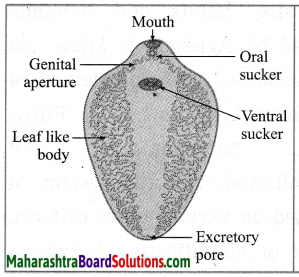
Classification:
Kingdom: Animalia
Division: Non-chordata
Phylum: Platyhelminthes
Example: Liverfluke
2. Leench.
Answer:
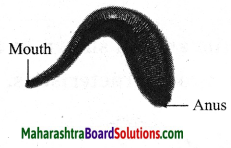
Classification:
Kingdom: Animalia
Division: Non-chordata
Phylum: Annelida
Example: Leech
3. Cockroach:
Answer:
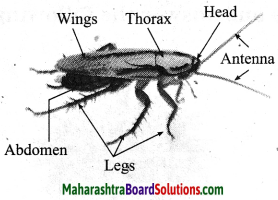
Classification:
Kingdom: Animalia
Division: Non-chordata
Phylum: Arthopoda
Class: Insecta
Example: Cockroach
Question 2.
Identify the animal given in the figure and label the figure:
1.
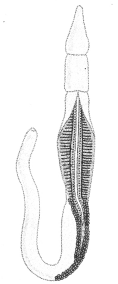
Answer:
Balanoglossus
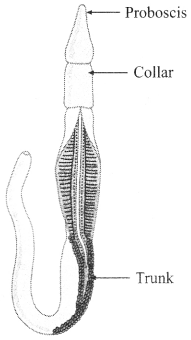
2.
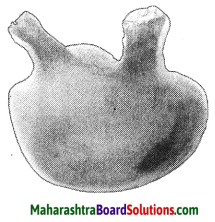
Answer:
Herdmania.
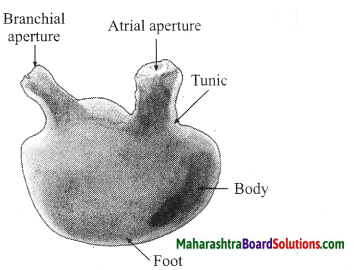
3.

Answer:
Amphioxus
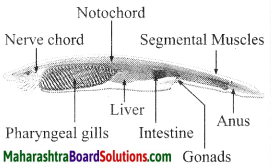
4.

Answer:
Petromyzon.
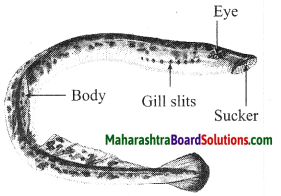
5.
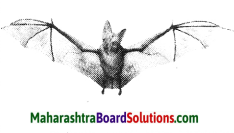
Answer:
bat
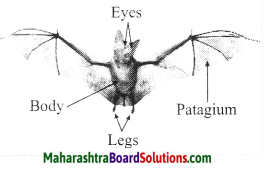
Question 3.
Identify the class of the animal shown in the figure and write any two characteristics.
Answer:
(1) The animal shown in the figure is bat.
(2) It belongs to class Mammalia of Subphylum Vertebrata. Phylum Chordata.
(3) Characteristics:
(i) Body is divided into head, neck, torso and tail. Patagium present for the flying mode. Nocturnal in habit. It is warm blooded.
(ii) Gives birth to live young ones. Mammary glands present for nourishing young ones.
![]()
Question 4.
Observe the figure and answer the following questions.

(a) To which phylum these organisms belong?
(b) Name the substance with which their body is covered.
(c) Name their organs of locomotion.
Answer:
(a) The starfish and the sea urchin shown in the figure belong to phylum Echinodermata.
(b) The body of echinoderm animal is covered with calcareous spines or ossicles/plates.
This is the substance covering the body is mostly calcium salts and compounds.
(c) Their locomotory organs are tube feet.
Question 5.
Observe the figures given below and answer the given questions: (Board’s Model Activity Sheet)

(a) In which phylum are these animals included?
(b) Which substance forms the outer layer of their exoskeleton?
(c) What are their locomotory organs?
Answer:
(a) These animals are included in phylum Arthropoda.
(b) The outer layer of their exoskeleton is covered by chitinous substance.
(c) Their locomotory organs are jointed paired appendages.
Question 6.
Identify the phylum of the given animal and write any two characteristics of this phylum. (Board’s Model Activity Sheet)
Answer:
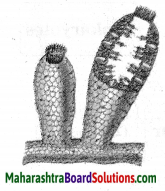
This animal is Sycon sponge and its phylum in Porifera.
Characteristics of phylum Porifera
(a) Asymmetrical body.
(b) Many pores on body. Large osculum and smaller ostia.
Question 7.
(a) Identify the animal given here.
(b) Write the phylum to which it belongs.
(c) Identify the pointed parts; p, q, r and s.
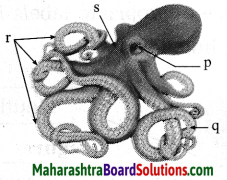
Answer:
(a) The given animal is Octopus.
(b) It belongs to the phylum Mollusca.
(c) p = eye, q = sucker, s = siphon and r = tentacle.
Complete the following charts:
Question 1.
Complete the chart by taking into consideration the criteria for classification: (Text Book Page No. 61)

Answer:
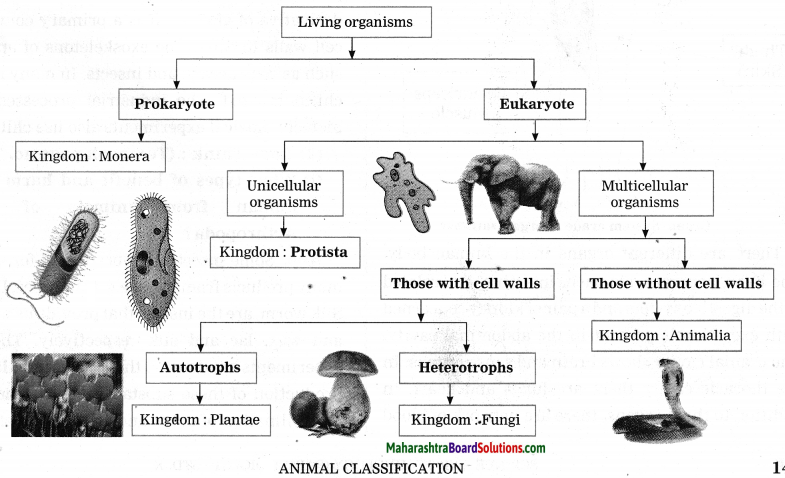
Question 2.
Complete the following flow-chart.

Answer:
(A) Eukaryotes
(B) Monera.
![]()
Activity based questions:
Question 1.
Observe: (Text Book Page No. 65)
(1) Body organization of human has been shown in the following figure. Use appropriate labels for different organs present in human body.

Answer:
There are different organs in the human body. The liver, pancreas, stomach, intestine, etc. related to the digestive system and a pair of kidney concerned with excretion is present in the abdominal cavity. The cranial cavity shows brain and sense organs. In the thoracic cavity there are lungs and heart. In addition to these organs, there are network of blood capillaries, nerve network, etc. which is spread from head to toes.
Question 2.
Why is earthworm called as friend of farmers? (Get Information: Text Book Page No. 69)
Answer:
Earthworms move through the soil in the farms and fields. They feed on the detritus in the soil. They also help in decomposition of the organic matter. When the soil is loosened due to their activities, the roots of the crops grow well. They enrich the soil by their excreta which act as fertilizers. All these facts make earthworm, a farmer’s friend.
Question 3.
In what way the leech is used in ayurvedic system of treatment? (Get Information: Text Book Page No. 69)
Answer:
Leeches are blood sucking ectoparasite. In Ayurveda leech is used to remove impure blood and blood clots. Such blood is sucked up by leeches and then the patient gets some relief. In the leech body there is. a substance called hirudine which prevent blood clotting as it sucks up the blood. This hirudine is also used for medicinal purpose.
Question 4.
What is chitin? (Find out: Text Book Page No. 70)
Answer:
Chitin is a type of polysaccharide. Its chemical formula is (C8H13O5N)n. It is a long-chain polymer of N-acetylglucosamine, which is actually a derivative of glucose. It is a primary component of cell walls in fungi, the exoskeletons of arthropods, such as crustaceans and insects. In many medicines chitin is used. The industrial processes and the biotechnological experiments also use chitin.
Question 5.
Let’s Think: (Text Book Page No. 70)
(i) What types of benefit and harm occur to human from animals of phylum-Arthropoda?
Answer:
Some insects are very useful for us. We get many products from them. e.g. Honey bee, Lac insect, Silk worm, are the insects that provide us with honey and wax, lac and silk respectively. The culture experiments are done on these insects for large scale production of these substances. Butterflies help in the pollination of crops and are thus helpful for the farmers and gardeners. Lady bug beetle is an insect which acts as a natural pest control as it attacks the other harmful insect pests.
In biological pest control methods it is widely used. Some insects, on the contrary are very harmful. Mosquito, bed bugs, lice are blood sucking parasites which can spread the diseases. Mosquito is a vector for dengue, filariasis and malaria. Some are biting insects that can cause wounds, some cause allergies of various kinds. The grains and crops are destroyed to great extent by the insects. In this way the insects belonging to the phylum Arthropods are harmful to health, wealth and peace of mind too.
(ii) Which are the animals from phylum Arthropoda those have shortest and longest life span?
Answer:
The shortest life span: May fly – About 24 hours. The longest life span : Lobster (Homarus americanus) – About 100 years.
(iii) Why has it been said that only insects directly compete with humans for food?
Answer:
The standing crop in the fields can be totally ruined by insects. The locust can damage the crops when they attack in thousands at a time. The grains are also infested by variety of insects like ants, weevils, beetles, etc. Therefore, we can say that only insects compete with humans for food.
![]()
Project: (Do it your self)
Project 1.
How does the infection of tapeworm in man, liver fluke in grazing animals like goat and sheep occur and what are their preventive measures? (Collect the Information, Internet is my friend: Textbook page no. 69)
Project 2.
How does the infection of round worms like Ascaris, filarial worm and plant nematodes occur and what are their preventive measures and treatment? (Collect the Information, Internet is my friend: Textbook page no. 69)
Project 3.
Books are my friend: Collect the information about pearl production from bivalves by reading appropriate books. (Textbook page no. 70)
Project 4.
Book are my friends: The Animal Kingdom: Libbie Hyman and some other similar books.
(Textbook page no. 75)
Project 5.
Use of Information Technology: (Textbook page no. 75)
Prepare the presentation of animal classification using video clips downloaded from internet.




